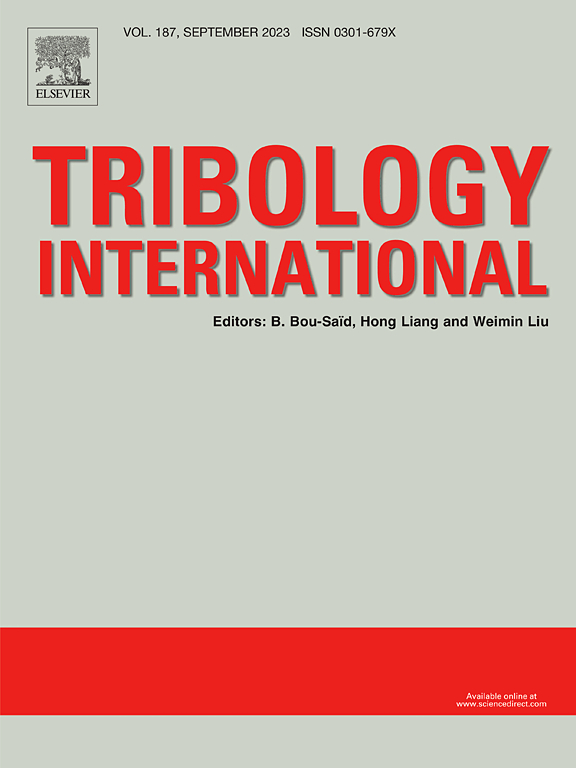Machine learning approach to the assessment and prediction of solid particle erosion of metals
IF 6.1
1区 工程技术
Q1 ENGINEERING, MECHANICAL
引用次数: 0
Abstract
Solid particle erosion (SPE) is a tribological phenomenon in which a surface is impacted by a stream of particles, causing gradual removal of material. This poses significant challenges in aerospace, particularly when operating in harsh environments. Despite decades of data gathering and empirical model development, accurately predicting SPE remains challenging due to the complexity of the phenomenon and the variability in testing conditions. In this study, we compiled a database of over 1000 erosion tests on metals from existing studies and internal experiments, noting material properties, test conditions, and literature metadata. Machine learning (ML) models, including Random Forest, Neural Networks, Support Vector Regression, and XGBoost were employed to predict erosion rates. XGBoost was most performant, achieving a mean absolute error of 15–16 % on test data. Model performance was further validated by predicting results published in the ASTM G76 standard; predictions were within the interlaboratory standard deviation for tests at 70 m/s. Feature importance and partial dependence plots were used to evaluate the influence of different variables on erosion predictions. While particle velocity, particle size, and impact angle show the expected influence, features such as target density and Poisson’s ratio showed exaggerated effects due to their role in classifying outlier materials. These results show the promise of ML for SPE prediction across a range of conditions and suggest that the broader erosion literature is valuable for quantitative predictions, while also acknowledging limitations in the ML approach, particularly where data sparsity and feature correlations hinder the accurate assessment of feature influence.
金属固体颗粒侵蚀评估与预测的机器学习方法
固体颗粒侵蚀(SPE)是一种摩擦学现象,在这种现象中,表面受到颗粒流的冲击,导致材料逐渐脱落。这在航空航天领域提出了重大挑战,特别是在恶劣环境下运行时。尽管经过数十年的数据收集和经验模型开发,但由于现象的复杂性和测试条件的可变性,准确预测SPE仍然具有挑战性。在这项研究中,我们从现有研究和内部实验中编译了一个超过1000个金属侵蚀测试的数据库,并注明了材料特性、测试条件和文献元数据。采用机器学习(ML)模型,包括随机森林、神经网络、支持向量回归和XGBoost来预测侵蚀率。XGBoost性能最好,在测试数据上的平均绝对误差为15 - 16% %。通过预测ASTM G76标准中公布的结果,进一步验证了模型的性能;预测结果在实验室间标准偏差范围内,测试速度为70 m/s。利用特征重要性图和部分依赖图来评价不同变量对侵蚀预测的影响。虽然粒子速度、粒径和冲击角显示出预期的影响,但目标密度和泊松比等特征由于其对异常材料的分类作用而表现出夸大的影响。这些结果显示了机器学习在一系列条件下SPE预测的前景,并表明更广泛的侵蚀文献对于定量预测是有价值的,同时也承认机器学习方法的局限性,特别是在数据稀疏性和特征相关性阻碍了特征影响的准确评估的情况下。
本文章由计算机程序翻译,如有差异,请以英文原文为准。
求助全文
约1分钟内获得全文
求助全文
来源期刊

Tribology International
工程技术-工程:机械
CiteScore
10.10
自引率
16.10%
发文量
627
审稿时长
35 days
期刊介绍:
Tribology is the science of rubbing surfaces and contributes to every facet of our everyday life, from live cell friction to engine lubrication and seismology. As such tribology is truly multidisciplinary and this extraordinary breadth of scientific interest is reflected in the scope of Tribology International.
Tribology International seeks to publish original research papers of the highest scientific quality to provide an archival resource for scientists from all backgrounds. Written contributions are invited reporting experimental and modelling studies both in established areas of tribology and emerging fields. Scientific topics include the physics or chemistry of tribo-surfaces, bio-tribology, surface engineering and materials, contact mechanics, nano-tribology, lubricants and hydrodynamic lubrication.
 求助内容:
求助内容: 应助结果提醒方式:
应助结果提醒方式:


